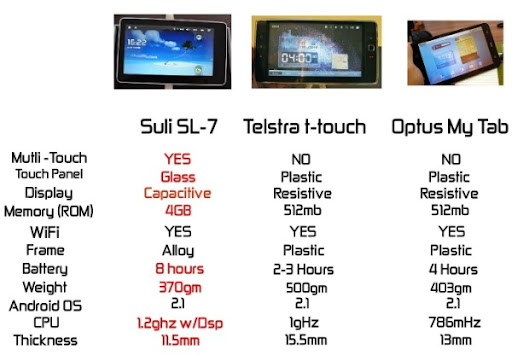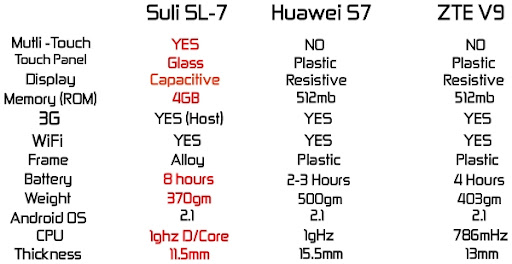Chrome OS greatest achievement will be the disruption of the whole Windows/Intel/Apple business models of artificially increasing prices of Laptops year after year, as those old silicon valley giants are always frightened to see their multi-hundred billion dollar industry disappear.
What the One Laptop Per Child successfully initiated after 2006, forcing Intel to introduce the Netbook market segment, thus lowering the average price per laptop consumers would purchase by $100-200 overnight, Google is attempting to do even more aggressively with Chrome OS.
These past 2 years, I reviewed several ARM Powered $99 Laptops already, from such Chinese as Hivision, MenQ, Firstview or Indian AllGo Systems, powered by VIA’s Wondermedia or other of the affordable ARM9 or ARM11 platforms that are available to these manufacturers for affordable implementation at that time. Sure enough, ARM Cortex A8 and A9, more RAM, faster SoCs are more appropriate for full laptop performance. Every 18 months chips are twice as fast or twice cheaper. How much more do you think that a new ARM Cortex-A9 SoC platform with a larger higher resolution LCD screen costs today compared to an ARM9 from 2 years ago? $30 more? The same? These cheap ARM Powered laptops are interesting because they are early products that have been giving us a taste of the ARM Powered laptops that are coming.
Sure the Cr-48 that Google are beta testing is Intel powered. That is just a question of beta testing of software. ARM Powered Chrome OS probably needs ARM Cortex-A8 and Cortex-A9 processors to be optimized for large screen laptop computing. The Chrome Browser requires a lot of RAM to be fast. All the I/O and memories on the SoC need to be accelerated to the point the Chrome web browser in a laptop form factor feels 100% as fast on ARM as on Intel.
It may be that the current generation ARM Cortex-A8 and Cortex-A9 are more suitable for Tablets and Smart Phones than for Laptops and Desktops. More likely, it is that Google has enough to beta test on Intel that they cannot advertise simultaneous beta testing on ARM at this moment as well.
In any ways, it might still be months before mass market Chrome OS laptops are sold to consumers. So clearly the Cr-48 being Intel doesn’t have to be an indication of ARM being “not ready” but instead might be simply a question of Google focusing their beta testing program on Intel for now. ARM and Intel based Chrome OS may still actually be released simultaneously to consumers next year.
Also consider the fact Intel CEO Paul Otelinni is also on the board of directors of Google, mysteriously. And that pressure from Intel on Google might convince Google to do such things as Chrome OS and Google TV with Intel first, all the while Google knows that ARM is the best platform eventually for both projects. Although Google TV is released to consumers, it’s still limited in size to one similar to beta testing, it’s like when Google releases a Nexus phone, they don’t do it to sell many Nexus phones, they do it to push their software platform forward, which always turns out that the industry combined sells more Google based devices than all other.
This is what I think Google plans to achieve with lower hardware pricing:
– $99 Google TV -> turns YouTube into larger share of people’s daily 5-hour TV watching, 10x increase in YouTube bandwidth when succeeded, changes outcome of elections brings more visionary high-tech favorable politicians to power
– $99 Chrome OS laptops -> realizes cloud computing dream, more ads served per user, enterprise all adopt Chrome OS for speed, security and price, brings in ecosystem for pay-per-web-app.
– $99 Pixel Qi Tablet/E-readers -> platform for Google e-books, full web experience on-the-go, more reading, outdoor use, more personal connection to the web
– $99 Gingerbread Smart Phones -> Google Voice true VOIP replaces telcos, eventually White Spaces is brought in to provide free wireless broadband. Google pushes Local services, location-based advertising brings in next hundred billion in revenues.
It only makes sense Google’s platforms will have the absolute largest market share in all these market segments. In all these segments, Google never plans to make profit on hardware, the hardware business is outsourced to manufacturers and brands, Google just plans for their platforms to dominate.
Price of Chrome OS laptops is the true revolution here.
As Google isn’t yet announcing the price, it may be hard for analysts to grasp the potential here.
How can a Google Chrome OS notebook be sold at $99?
1. ARM Powered laptops cost half the price to manufacture compared to Intel, even the Intel one can be sold $199, deduct at least Windows licence and Hard drive costs compared to a “regular” netbook, that’s 5-10 times cheaper than the Macbook air.
2. Removing hard drive, simplifying motherboard lowers cost.
3. Google makes money later on ads. Seriously, do a calculation how much advertising money Google makes on each of their users, divide their yearly reported revenues by the number of users, Chrome OS users will see even more Google ads than other.
4. Google and Telecoms make money later on selling on-demand 3G/4G wireless data. Even as this should be sold without compulsory subscription plan, the pricing and ease of use should be so tempting, a large share of users will potentially spend hundreds of dollars for on-demand wireless data service. This should be built-in, perhaps not even a SIM card slot, allows Google to also negociate 3G/4G bandwidth deals in all countries worldwide. If prices change in other countries, simply click boom to accept and you’ve got on-demand wireless bandwidth.
5. Google and Developers will make money later on selling apps. Eventually monetization of web apps will be more than just ads. Even enterprise stuff like Google Apps, Citrix stuff and other Virtualization of Windows/Mac x86 apps, those kinds of services could generate up to thousands of dollars per user in the enterprise.
Critics of Google’s Chrome OS based cloud computing need to understand a few things about where it is and where it’s going:
– HTML5 apps can work offline and don’t have to be slower because of connectivity. Including Google Docs and potential cloud assisted video and photo editing, all can work offline.
– Native code and powerful 3D will be part of it. This means basicaly all apps you can imagine that are on Windows and Mac can also work here. I expect new cloud based versions of http://youtube.com/editor means even video editing professionals will rather want to use this type of cloud based apps for instant encoding and rendering using the power of thousands of grid processing servers on the cloud.
– WebGL and other advances in web browser technology increases potential complexity of web apps.
– A 32GB SD card costs less than $49, a 500GB 2.5″ external USB hard drive costs $49, both work in Chrome OS, I even envision a Chrome OS laptop design with available slot to insert a 2.5″ hard drive and have it only powered when accessed.
– You can backup and sync your cloud easily on a $49 ARM Powered NAS such as a pogoplug in your home, connect any $99 3.5″ 2TB hard drive to that.
– Citrix has demonstrated, any x86 app you want can be virtualized in Chrome OS to actually run faster thanks to cloud grid app hosting than any local PC.






















